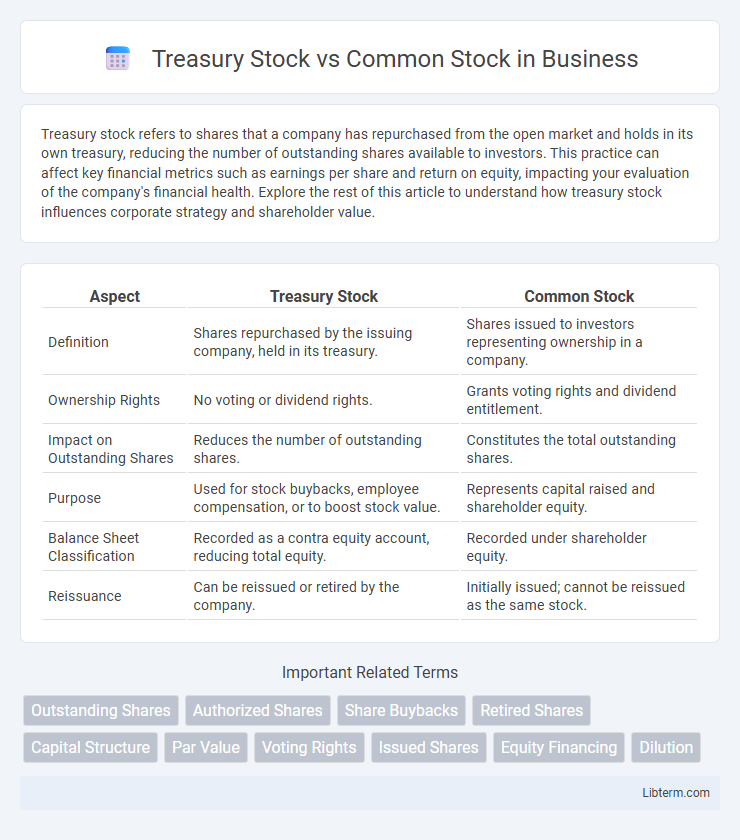Treasury stock refers to shares that a company has repurchased from the open market and holds in its own treasury, reducing the number of outstanding shares available to investors. This practice can affect key financial metrics such as earnings per share and return on equity, impacting your evaluation of the company's financial health. Explore the rest of this article to understand how treasury stock influences corporate strategy and shareholder value.
Table of Comparison
| Aspect | Treasury Stock | Common Stock |
|---|---|---|
| Definition | Shares repurchased by the issuing company, held in its treasury. | Shares issued to investors representing ownership in a company. |
| Ownership Rights | No voting or dividend rights. | Grants voting rights and dividend entitlement. |
| Impact on Outstanding Shares | Reduces the number of outstanding shares. | Constitutes the total outstanding shares. |
| Purpose | Used for stock buybacks, employee compensation, or to boost stock value. | Represents capital raised and shareholder equity. |
| Balance Sheet Classification | Recorded as a contra equity account, reducing total equity. | Recorded under shareholder equity. |
| Reissuance | Can be reissued or retired by the company. | Initially issued; cannot be reissued as the same stock. |
Introduction to Treasury Stock and Common Stock
Treasury stock represents shares that a company has repurchased and holds in its own treasury, reducing the total outstanding shares available to investors. Common stock refers to shares issued to investors, granting voting rights and potential dividends, serving as a fundamental source of equity capital. The key difference lies in treasury stock being non-outstanding shares that do not confer voting rights or dividends, while common stock actively participates in corporate governance and profit distribution.
Definition of Treasury Stock
Treasury stock refers to shares that a company has issued and subsequently repurchased from shareholders, reducing the total outstanding shares in the market. Unlike common stock, treasury stock does not have voting rights or pay dividends since it is held by the issuing company itself. This repurchased stock can be reissued or retired, impacting the company's equity structure and earnings per share metrics.
Definition of Common Stock
Common stock represents ownership shares in a corporation, granting shareholders voting rights and potential dividends. Treasury stock consists of previously issued shares that the company has repurchased and holds, which do not confer voting rights or dividend payments. Unlike treasury stock, common stock is actively traded on the market and reflects equity ownership available to investors.
Key Differences Between Treasury and Common Stock
Treasury stock represents shares repurchased by the company and held in its own treasury, whereas common stock consists of shares issued to and held by investors, granting voting rights and dividends. Treasury stock does not confer voting rights or dividends and reduces total shareholders' equity, while common stock increases equity and influences corporate control. The primary accounting distinction lies in treasury stock being recorded as a contra equity account, contrasting with common stock recorded at par value within shareholders' equity.
Purpose of Treasury Stock Transactions
Treasury stock transactions are primarily conducted to manage a company's capital structure and enhance shareholder value by repurchasing shares to reduce the number of outstanding common shares. This can improve financial ratios such as earnings per share (EPS) and return on equity (ROE), while providing flexibility for future financing needs or employee compensation plans. Unlike common stock issued for capital raising, treasury stock serves as a tool for strategic stock management and market perception control.
Rights and Privileges of Common Stockholders
Common stockholders hold voting rights, enabling them to influence corporate decisions such as electing the board of directors and approving mergers or acquisitions, while treasury stock carries no voting rights or dividends. Common stock also grants shareholders the right to receive dividends when declared and to share in the company's residual assets during liquidation after all debts and preferred stock obligations are settled. Treasury stock represents shares repurchased by the company, held in its treasury, and excluded from outstanding shares, thus lacking rights and privileges conferred on common stockholders.
Impact on Earnings Per Share (EPS)
Treasury stock reduces the number of outstanding shares, which can increase Earnings Per Share (EPS) by concentrating net income among fewer shares. Common stock issuance enlarges the share base, potentially diluting EPS as net income is spread across more shares. Companies strategically manage treasury and common stock activities to influence EPS metrics for investor perception and financial performance reporting.
Accounting Treatment for Treasury and Common Stock
Treasury stock is recorded as a contra equity account at the cost of reacquisition, reducing total shareholders' equity without affecting the income statement. Common stock is recorded at par value or stated value upon issuance, increasing equity and reflected under paid-in capital. Treasury stock transactions do not impact net income, while common stock issuance impacts both equity accounts and cash or other consideration received.
Effects on Shareholder Equity
Treasury stock reduces total shareholder equity by the amount spent to reacquire shares, resulting in a decrease in the equity section of the balance sheet and a corresponding decline in earnings per share. Common stock represents ownership equity and increases shareholder equity based on the par value of issued shares, reflecting capital contributed by investors. The retention or reissuance of treasury stock does not affect net income but influences the equity composition and per-share financial metrics.
Choosing Between Treasury Stock and Common Stock
Choosing between treasury stock and common stock depends on a company's financial strategy and shareholder objectives. Treasury stock represents shares repurchased by the company, reducing outstanding shares and potentially increasing earnings per share, while common stock reflects shares issued to investors, offering voting rights and dividend participation. Companies aiming to consolidate control or manage equity may prefer treasury stock, whereas raising capital and expanding ownership involves issuing common stock.
Treasury Stock Infographic

 libterm.com
libterm.com